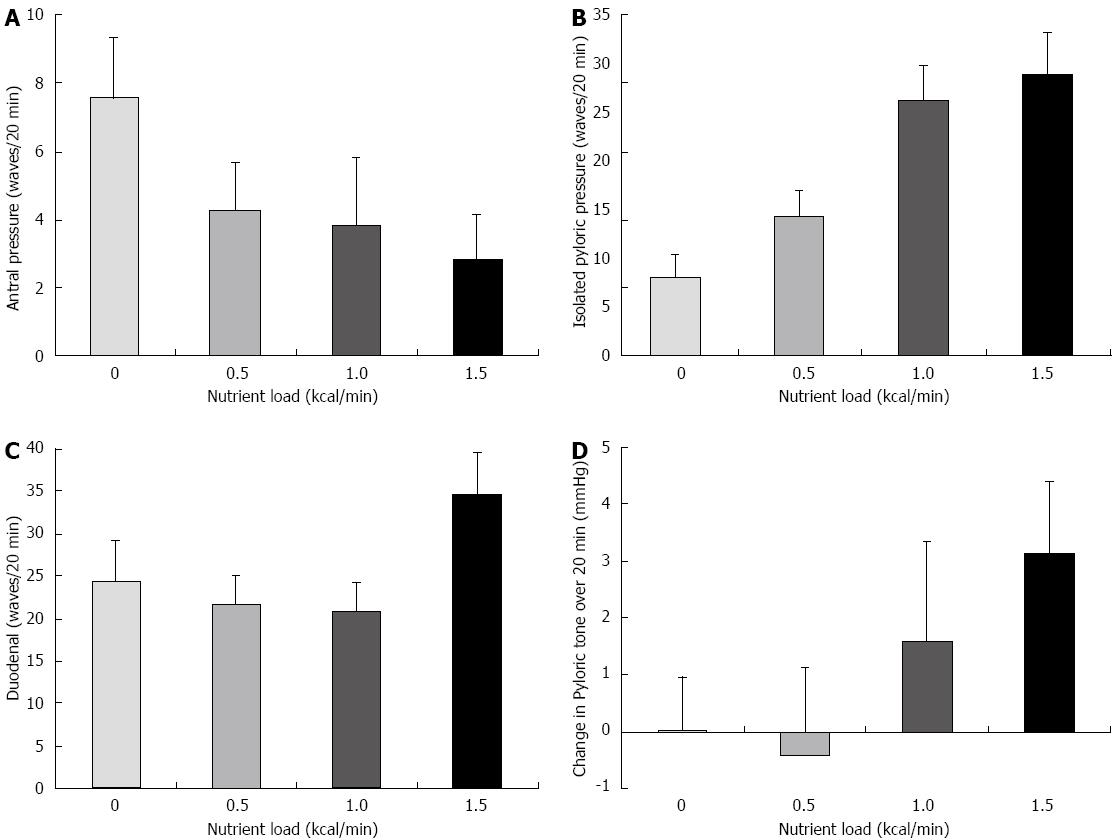Copyright
©2013 Baishideng Publishing Group Co.
World J Gastroenterol. Sep 21, 2013; 19(35): 5863-5869
Published online Sep 21, 2013. doi: 10.3748/wjg.v19.i35.5863
Published online Sep 21, 2013. doi: 10.3748/wjg.v19.i35.5863
Figure 1 Representative trace of intraluminal motility at (A) 0 kcal/min and at (B) 1.
5 kcal/min. Occlusive contraction waves commence in the antrum and propagate through the duodenum. At 1.5 kcal/min isolated pyloric pressure waves occurred more frequently and a reduction in propagated antral contractility was observed.
Figure 2 Antral, isolated pyloric, duodenal pressure waves and pyloric tone at differing caloric loads.
A: Reduction in antral motility occurred with increasing glucose load with marked attenuation of antral pressure wave activity at 1.5 kcal/min, when compared to 0 kcal/min (0 kcal/min: 7.5 ± 1.8 waves/20 min vs 1.5 kcal: 2.8 ± 1.3 waves/20 min; P = 0.007); B: The frequency of isolated pyloric pressure waves increased with increasing caloric load. The number of waves/20 min were statistically different between 0 and 1.0 kcal/min (0 kcal/min: 8.0 ± 2.3 waves/20 min vs 1.0 kcal/min: 25.9 ± 3.7 waves/20 min; P = 0.002); C: The nutrient load did not effect duodenal wave frequency when comparing 0 kcal/min to 1.5 kcal/min (0 kcal/min: 24.4 ± 4.7 waves/20 min vs 1.5 kcal/min: 34.7 ± 4.9 waves/20 min; P = 0.22); D: Pyloric tone increased in response to increasing caloric loads (P = 0.015). Between 0.5 and 1.5 kcal/min the difference was significant (0.5 kcal/min: -0.4 ± 1.1 mmHg vs 1.5 kcal/min: 3.1 ± 1.3 mmHg; P = 0.008).
- Citation: Deane AM, Besanko LK, Burgstad CM, Chapman MJ, Horowitz M, Fraser RJ. Modulation of individual components of gastric motor response to duodenal glucose. World J Gastroenterol 2013; 19(35): 5863-5869
- URL: https://www.wjgnet.com/1007-9327/full/v19/i35/5863.htm
- DOI: https://dx.doi.org/10.3748/wjg.v19.i35.5863










